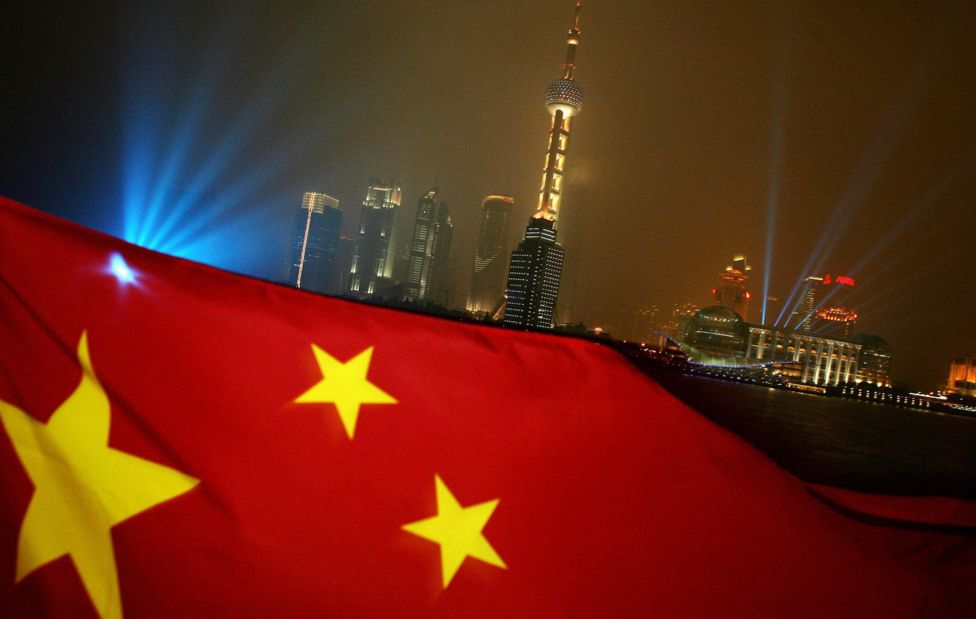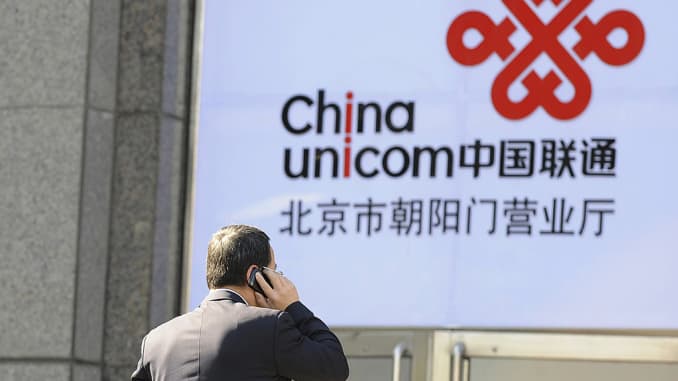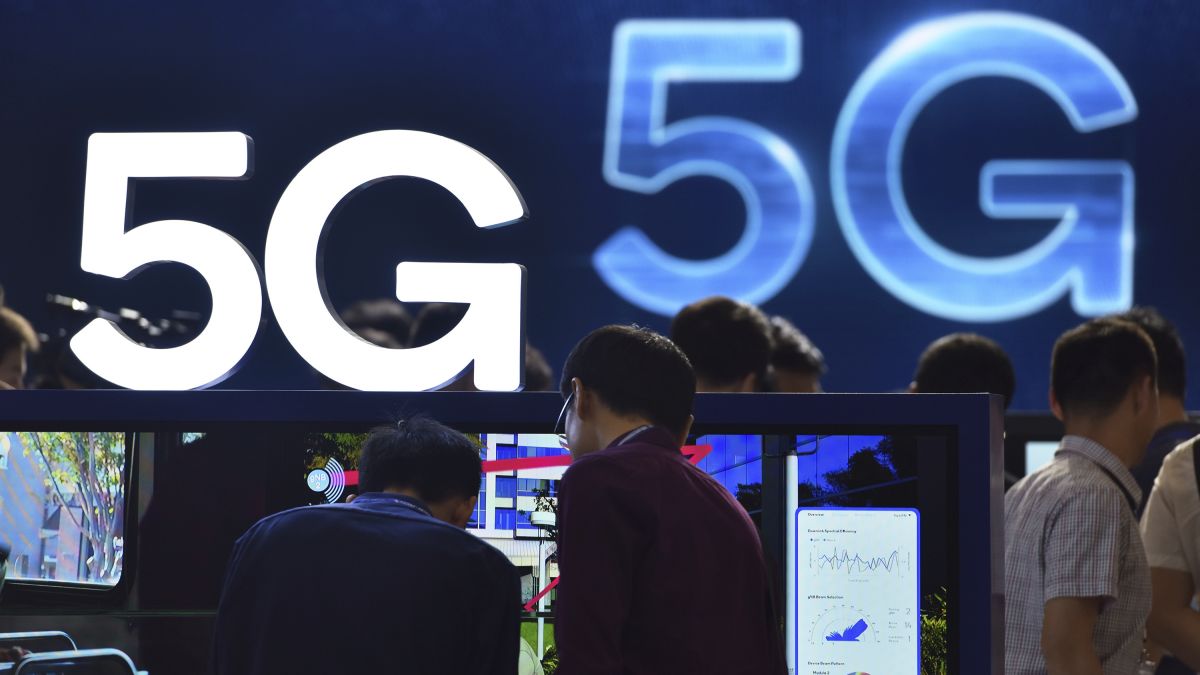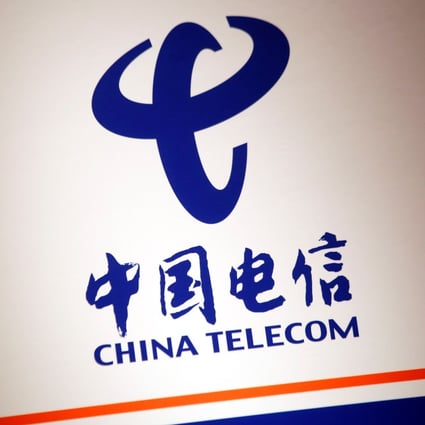China Unicom
China Tower had ~2.1M telecom towers installed with 3.36M tower tenants at end of 2022
China Tower ended 2022 with 2.05 million telecom towers installed, representing a net increase of 17,000 sites from the end of 2021. The company installed approximately 745,000 5G base-stations during the year, with more than 96 percent of sites delivered through sharing existing network infrastructure. Through the end of 2022, China Tower reported that it has received cumulative orders of nearly 1.8 million new 5G cell sites. The total tower tenants rose by 102,000 in the year to 3.36 million, pushing the average number per tower from 1.62 as of the end of 2021 to 1.65 at end-2022.
China Tower primarily serves the country’s state-owned telecommunications service providers (TSP) – China Mobile, China Telecom, China Unicom, and China Broadnet. The four TSPs accounted for a total of nearly 3.4 million tower tenants, a 102,000 year-over-year increase. The TSP tenancy ratio increased from 1.60 to 1.65 over the same period last year, showing a continuous increase in the level of site colocation.
Operating revenue for 2022 reached $13.4 billion, up 6.5 percent YoY. Revenue from the TSP segment was $12.0 billion, up by 3.5 percent over the same period last year, and accounting for 90 percent of operating revenue. The TSP business comprises revenue from towers and indoor distributed antenna system (DAS) business. Towers contributed $11.3 billion, up nearly 2 percent, while DAS revenue was $845 million, a 34 percent YoY increase. Capital expenditures for new tower builds and site augmentation was $3.0 billion in 2022, up 5 percent over nearly $2.9 billion in 2021.
The company sees “5G + DAS” as its dual-growth engines, with DAS as the fastest growing segment. The DAS business focuses on providing 5G coverage under various scenarios in key sectors including education, cultural tourism, transportation, and healthcare, with an integrated approach to coordinating resources and demands.
At year-end 2022, China Tower’s DAS deployments covered buildings with a cumulative area of 7,390 million square meters, representing a 48 percent YoY increase. The company expanded DAS coverage to 10,429 kilometers in high-speed railway tunnels and to 9,611 kilometers in subways, coverage reaching a cumulative length of 20,040 kilometers, up 19 percent from a year ago.
China Tower has Commercial Pricing Agreements and Service Agreements with each of the TSPs. In a statement, the company reiterated its commitment to meeting its TSP customer network construction needs using innovative construction and service models that provide low-cost and efficient coverage.
Zhang Zhiyong, chairman of China Tower said: “Looking ahead, we will remain focused on grasping the opportunities brought by the development of 5G new infrastructure, the digital economy, and the green-oriented transition of energy. With a focus on “Digital Tower,” our Smart Tower business growth accelerated. Serving the national strategic goals.”
Tower business. China Tower advocated for the inclusion of 5G base-station sites in development planning and played an active role in setting the wireless communications specifications for buildings. Complying with these specifications, we have been included in the administrative approval process for new construction projects, further strengthening our ability to coordinate and share resources. We launched innovative low-cost construction solutions to sharpen our capability in providing integrated wireless communications coverage solutions. A higher level of resource sharing enabled us to comprehensively satisfy customer demand for 5G construction. We completed approximately 745,000 5G base-stations during the year, of which more than 96% were delivered through sharing existing resources. In addition, we focused our efforts on tackling difficult sites and continued to enhance our service quality. Alongside an improving capability in site maintenance, customer satisfaction grew. In 2022, our Tower business generated revenue of RMB77,204 million, or year-on-year growth of 1.8%. As of 31 December 2022, we managed 2.055 million tower sites, representing a net increase of 17,000 sites from the end of 2021. The number of TSP tenants reached 3.362 million, an increase of 102,000 from the end of 2021, and the TSP tenancy ratio also increased from 1.60 to 1.65 over the same period of last year, showing a continuous increase in the level of site co-location.
DAS business. China Tower focused on providing 5G coverage for key scenarios and key sectors including education, cultural tourism, transportation and healthcare, with an integrated approach to coordinating resources and demands. Playing an important role in coordinating site entry and construction, we were able to take up all DAS construction demand for key venues, scenarios and sectors, providing customers with differentiated and diversified indoor coverage solutions. In addition, we stepped up innovation to develop sharable DAS products and solutions. We enhanced our professional capabilities to optimize our advantages in providing low-cost and green and low-carbon DAS solutions, complemented by our quality services, driving accelerated growth in the DAS business. This business has increasingly become the second growth engine of our development. In 2022, our DAS business recorded revenue of RMB5,827 million, representing a year-on-year increase of 34.3%. As of 31 December 2022, we had covered buildings with a cumulative area of 7,390 million square meters, representing a year-on-year increase of 48.1%. Our high-speed railway tunnels and subway coverage reached a cumulative length of 20,040.2 kilometers, a year-on-year increase of 18.5%.
Grasping strategic opportunities to boost strong growth in Two Wings business:
By leveraging the opportunities brought forth by the growth of the “digital economy” and the “dual carbon” goals, we focused on product innovation and business optimization to fortify our competitive advantages. As a result, the Two Wings business sustained a robust growth trajectory with revenue in 2022 reaching RMB8,904 and accounting for 9.7% of our overall operating revenue, an increase of 2.6 percentage points from the same period in 2021. The business contributed 49.7% to our incremental operating revenue for the year, an increase of 9.7 percentage points year-on-year, further solidifying our multi-pillar business development structure.

Image courtesy of China Tower
…………………………………………………………………………………………………………………………………………………………………………………………
China’s wireless network operators had deployed a total of 2.29 million 5G base stations nationwide as of the end of November, according to the latest available data from China’s Ministry of Industry and Information Technology. This figure represents an increase of 862,000 compared to the end of 2021 and accounts for 21.1% of all mobile base stations in the country.
Chinese operators recorded a net gain of 16.53 million 5G subscribers in January, according to the operators’ latest available statistics. China Mobile, the world’s largest operator in terms of subscribers, added a total of 8.46 million 5G subscribers during the first month of the year. The carrier said it ended last month with 622.47 million 5G subscribers. China Mobile added a total of 227.2 million subscribers in the 5G segment during 2022.
Meanwhile, China Telecom added 5 million 5G subscribers last month to take its total 5G subscribers base to 273 million. During 2022, the telco added a total of 80.16 million 5G subscribers.
Rival operator China Unicom said it added a total of 3.07 million 5G subscribers during last month. The carrier ended January with 215.8 million 5G subscribers. China Unicom added over 42 million subscribers in the 5G segment during 2022.
…………………………………………………………………………………………………………………………………………………………………………………………
References:
China MIIT claim: 475M 5G mobile users, 1.97M 5G base stations at end of July 2022
China’s MIIT to prioritize 6G project, accelerate 5G and gigabit optical network deployments in 2023
China’s telecom revenue: +8.1% YoY from Jan-Nov 2021
With the caveat that you can’t trust any economic numbers reported by China’s government………….
China’s Ministry of Industry and Information Technology says that the country’s telecommunications industry registered robust growth in revenue in the first 11 months of this year, according to “official data.”
The combined industrial revenue rose 8.1% year on year (YoY) to over 1.35 trillion yuan (about 212 billion U.S. dollars) in the January-November period.
The growth was down 0.1 percentage points from the figure for the January-October period, the data showed.
By the end of November, China’s three state owned telecom giants — China Telecom, China Mobile and China Unicom — had over 1.64 billion mobile phone users, a net increase of 47.92 million users compared with the end of last year. The number of 5G mobile subscribers reached 497 million, up 298 million from the end of last year, according to the ministry.

A poster of commercial 5G applications shown outside a branch of China Telecom in Beijing. Photo Credit: SHEN BOHAN/XINHUA
…………………………………………………………………………………………….
China’s big three telecom companies also saw a steady increase in the number of fixed broadband internet users by the end of November, with subscribers rising by 51.85 million from the end of last year to stand at 535 million.
……………………………………………………………………………………….
As of 2021, China is the only country known to work towards a single-stack IPv6 network. The country announced plans in 2017 to lead globally in IPV6 adoption by 2025, and achieve full nationwide rollout by 2030. Experts believe that such a plan to widely adopt IPv6 for the country’s internet infrastructure, can help China to increase its leadership in 5G and Internet of Things (IoT) across multiple varying industries.
References:
http://www.china.org.cn/business/2021-12/26/content_77953625.htm
https://en.wikipedia.org/wiki/Telecommunications_industry_in_China
China telcos add 43.71 5G subscribers in July, while capital spending declines
5G Subscriber Adds:
China’s network operators recorded a net addition of 43.71 million 5G subscribers in July, according to the carriers’ latest available reports.
- China Mobile, the world’s largest operator in terms of subscribers, added 28.91 million 5G subscribers in July. It had 279.60 million 5G subscribers at the end of July, compared to 84.05 million 5G customers in July 2020. The telco’s overall mobile subscriber base at the end of July reached 947.46 million, up compared to 945.50 million in June 2020.
- China Unicom said it added a total of 7.74 million 5G subscribers during July. During the first seven months of the year, Unicom added a total of 50.24 million 5G subscribers. The telco ended July with 121.07 million 5G subscribers. China Unicom reported an overall mobile base of with 311.61 million subscribers at the end of last month, up from 310.45 million in June.
- China Telecom added 7.06 million 5G subscribers in July to take its total 5G subscribers base to 138.21 million. The telco added 51.71 million 5G customers in the January-July period. China Telecom’s overall mobile base amounted to 364.62 million subscribers at the end of the July, after adding 2.13 million customers during the month.
China Telco CAPEX Crash:
However, total capital spending by the three state owned China telecom operators declined by 35% in the first half, with the number of new 5G base stations down 34% compared with last year. Spending on 5G by the two biggest telcos, China Mobile and China Telecom, slid 19%. China Unicom, has not disclosed its 5G spending but said it had reached only a fifth of its full-year capex target.
China Unicom revealed it had spent only RMB14 billion ($2.2 billion) of its 2021 capex budget of RMB70 billion ($10.8 billion), down 45% from 2020. It has a year-end target for 5G of RMB35 billion ($5.4 billion), the same as 2020.
China Mobile’s 5G investment of RMB50.2 billion ($7.8 billion) was 9% lower than last year, and only 46% of its full-year target of RMB110 billion ($17 billion).
China Tower reported a 28% fall in capex to 10.4 billion yuan ($1.6 billion).
China Telecom’s 5G spend plunged 45% to RMB11.1 billion ($1.71 billion), just over a quarter of its full-year forecast of RMB39.7 billion ($6.1 billion). Total capex declined 37% for the half. From the Chinese website Yicai.com:
From the data point of view, China Telecom’s capital expenditure in the first half of this year was less than one-third of the annual capital expenditure, and the investment progress was lagging behind. Liu Guiqing said that 5G was the largest investment in the first half of the year, including investment in 3.5GHz and 2.1GHz equipment. “On the whole, the investment in 3.5GHz equipment is relatively normal; for 2.1GHz investment, we make corresponding adaptations according to the current situation of the entire industry chain and the terminal ecology. At present, the purchase of 2.1GHz equipment has been completed, 3.5GHz telecom equipment is being negotiated, and there will be results soon.” He said that 87 billion yuan of investment can be completed this year, of which 5G investment is 39.7 billion yuan.

The China telcos maintain the same capex guidance for the full year of around 185 billion yuan ($28.6 billion), slightly up from last year’s 182 billion yuan ($28.1 billion). Yet for China Telecom and China Unicom, those capex numbers look quite challenging.
…………………………………………………………………………………………………………………………………….
5G Base Station Builds:
China’s three major mobile carriers have already activated 961,000 5G base stations and connected 365 million 5G-compatible devices by end-June, Chinese press reported, citing comments by press secretary for the Ministry of Industry and Information Technology (MIIT) Tian Yulong.
Unicom said it had built just 80,000 new base stations in the first half and was aiming to deploy another 240,000 in the latter half of this year.
Meanwhile, China Broadcast Network and China Mobile have recently completed a tender to deploy 400,000 5G base stations this year, as part of the companies’ efforts to launch a shared 5G network. The contracts had been won by Huawei, ZTE, Datang, Nokia and Ericsson.
China Mobile has attributed its lower 5G investment to issues around its partnership with China Broadcast Network in building a new 5G network in the 700MHz band. The main tender was set in July. China’s 5G rollout is a high priority infrastructure project closely supervised by the national government. The two carriers expect this shared 5G network to reach nationwide coverage within the next two years.
………………………………………………………………………………………………………………………………….
5G Subscriber Forecast & 5G SA Core Network:
China is forecast to reach 739 million 5G subscribers by 2025, according to a recent study by ABI Research. That would represent nearly 40% of the total global 5G subscriber market.
Earlier this year, Liu Liehong, vice minister of industry and information technology, had said that 5G Standalone (5G SA) networks covered all prefecture-level cities across China.
We wonder if all China’s telcos have implemented the same specification for 5G SA/core network and whether it is “cloud native” or not? Also, whether they use NFV (virtual machines) or containers?
Note there is no standard or implementation specification(s) that would ensure vendor interoperability on 5G SA networks from different telcos.
……………………………………………………………………………………………………………………………………………
References:
https://www.rcrwireless.com/20210824/5g/chinese-carriers-add-43-million-5g-subscribers-july
https://www.lightreading.com/5g/chip-shortage-taking-its-toll-on-china-5g-rollout/d/d-id/771681?
https://www.yicai.com/news/101136803.html
China Telcos Lose Subscribers; 5G “Co-build and Co-share” agreement to accelerate
Gartner: Worldwide 5G Network Infrastructure Revenues to Grow 39% in 2021
Worldwide 5G network infrastructure revenue is on pace to grow 39% to total $19.1 billion in 2021, up from $13.7 billion in 2020, according to the latest forecast by Gartner, Inc.
Communications service providers (CSPs) in mature markets accelerated 5G development in 2020 and 2021 with 5G representing 39% of total wireless infrastructure revenue this year.
“The COVID-19 pandemic spiked demand for optimized and ultrafast broadband connectivity to support work-from-home and bandwidth-hungry applications, such as streaming video, online gaming and social media applications,” said Michael Porowski, senior principal research analyst at Gartner.
5G is the fastest growing segment in the wireless network infrastructure market (see Table 1). Of the segments that comprise wireless infrastructure in this forecast, the only significant opportunity for investment growth is in 5G. Investment in legacy wireless generations is rapidly deteriorating across all regions and spending on non-5G small cells is poised to decline as CSPs move to 5G small cells.
Table 1: Wireless Network Infrastructure Revenue Forecast, Worldwide (Millions of U.S. Dollars)
| Segment | 2020 Revenue | 2021 Revenue | 2022 Revenue |
| 5G | 13,768.0 | 19,128.9 | 23,254.6 |
| LTE and 4G | 17,127.8 | 14,569.1 | 12,114.0 |
| 3G and 2G | 3,159.6 | 1,948.2 | 1,095.2 |
| Small Cells Non-5G | 6,588.5 | 7,117.9 | 7,113.9 |
| Mobile Core | 5,714.6 | 6,056.2 | 6,273.3 |
| Total | 46,358.5 | 48,820.2 | 49,851.0 |
Source: Gartner (August 2021)
Regionally, CSPs in North America are set to grow 5G revenue from $2.9 billion in 2020 to $4.3 billion in 2021, due, in part, to increased adoption of dynamic spectrum sharing and millimeter wave base stations. In Western Europe, CSPs will prioritize on licensing spectrum, modernizing mobile core infrastructure and navigating regulatory processes with 5G revenue expected to increase from $794 million in 2020 to $1.6 billion in 2021.
Greater China is expected to maintain the No.1 global position in global 5G revenue reaching $9.1 billion in 2021, up from $7.4 billion in 2020. With China’s government funding 5G development for the three state owned carriers, that’s no surprise.
The big beneficiaries of China’s 5G infrastructure spending will be its domestic equipment makers, Huawei, ZTE, and (state owned) Datang Telecom. Despite clamoring for Sweden to permit Huawei 5G equipment to be deployed, Ericsson only received 3% of a joint 5G radio contracts from China Telecom, China Unicom and 2% from China Mobile, according to Reuters. Nokia, which was expected to take away Ericsson’s market share in China, did not receive any share, according to a tender document published by the Chinese companies.
In a way that’s a win for the Swedish vendor – and a brief share price hike backs up that statement – which won just 2% of an earlier deal from China Mobile. But if they want to secure their share of the multiple billions of dollars of global 5G infrastructure revenues forecast by Gartner, the likes of Ericsson and Nokia will need to keep winning contracts in their home markets.
5G Coverage in Tier-1 Cities Will Reach 60% in 2024:
While 10% of CSPs in 2020 provided commercialized 5G services, which could achieve multiregional availability, Gartner predicts that this number will increase to 60% by 2024, which is a similar rate of adoption for 4G- LTE in the past.
“Business and customer demand is an influencing factor in this growth. As consumers return to the office, they will continue to upgrade or switch to gigabit fiber to the home (FTTH) service as connectivity has become an essential remote work service,” said Porowski. “Users will also increasingly scrutinize CSPs for both office and remote work needs.”

This rapid shift in customer behavior is driving growth in the global passive optical network (PON) market as a preferred technology. The 10-Gigabit-capable symmetric-PON (XGS-PON) is not a new technology and with the price difference with other technologies narrowing, CSPs are willing to invest in XGS-PON to differentiate themselves in customer experience and network quality. Gartner estimates that by 2025, 60% of Tier-1 CSPs will adopt XGS-PON technology at large-scale to deliver ultrafast broadband services to residential and business users, up from less than 30% in 2020.
Gartner clients can learn more in the reports “Forecast Analysis: Communications Service Provider Operational Technology, Worldwide” and “Forecast: Communications Service Provider Operational Technology, Worldwide, 2019-2025, 2Q21 Update.”
…………………………………………………………………………………………
Small Cells?
While Gartner did not split out small cells’ contribution to the overall 5G infrastructure segment, evidence thus far suggests the market is progressing more slowly than many had once believed.
Last month, Crown Castle increased its guidance for the second time this year due to a strong cell towers market, but halved the number of small cells it expects to deploy in 2021 to 5,000. The company noted that wireless network operators have focused on tower-based 5G rollouts at the expense of small cells.
References:
5G network kit revenues to near $20 billion this year — report
MIIT: China has 260M 5G subs; Telecom business revenue significantly increased
China telecom regulator MIIT (Ministry of Industry and Information Technology) revealed this week that China has 260 million 5G subscribers at the end of February 2021. That is a huge number and more than the rest of the world combined [1.], but still a long way short of the 361 million claimed by the three operators. in February.
- China Mobile reported 173.2 million 5G package customers compared to 15.4 million 5G customers in February 2020. China Mobile’s overall mobile subscriber base was said to be 937.16 million at the end of February, down from 940.86 million in January.
- China Telecom added a total of 6.2 million 5G subscribers in February 2021 for a total of 103.4 million.
- China Unicom had 84.5 million 5G subscribers at the end of February 2021.
Note 1. GSA says that global 5G subscriptions grew by 57% in the fourth quarter of 2020 to reach nearly 401 million globally (representing 4.19% of the entire global mobile market). By the end of 2025, 5G will account for 31% of the global market (at 3.39 billion subscriptions), although LTE will still be dominant at 53.3% of all global mobile subscriptions.
……………………………………………………………………………………………………………………………………….
China’s vice-minister of industry and information technology Liu Liehong recently said that a total of 718,000 5G base stations have been built in China, accounting for nearly 70% of the world’s total 5G cell sites.
During Mobile World Congress Shanghai 2021, government officials said that Chinese carriers have invested more than CNY260 billion ($40.2 billion) to build the world’s largest 5G network.
MIIT further stated:
The growth rate of telecom business revenue has increased significantly. From January to February, the total revenue of telecommunications services reached 237.3 billion yuan, an increase of 5.8% year-on-year, and the growth rate increased by 4.3 percentage points year-on-year. The total telecommunications business calculated at the constant price of the previous year was 249.1 billion yuan, a year-on-year increase of 25.9%.
The scale of mobile phone users is basically stable, and 5G users are developing rapidly. As of the end of February, the total number of mobile phone users of the three basic telecommunications companies reached 1.592 billion, a year-on-year increase of 0.8%. As of the end of February, the number of 5G mobile terminal connections of the three basic telecommunications companies reached 260 million, a net increase of 61.3 million from the end of the previous year, accounting for 16.3% of mobile phone users.
Light Reading’s Robert Clark wrote: “The three (China) telcos’ annual filings over the past two weeks indicate that between them they spent a hefty 173 billion yuan ($26.5 billion) on 5G and they’re not slowing down; they’ve set aside another 185 billion yuan for 2021.”
“Their pricing, with plenty of encouragement from government officials, is also aggressive, with China Mobile’s 5G entry package costing just 128 yuan ($19.56). The heavy investment and the moderate pricing in pursuit of national objectives is why their results indicate little reward for the effort so far.”
MIIT also commented on other telecom services (besides 5G):
Data and Internet business revenue accounted for 60%, supporting the steady growth of overall telecom business revenue. From January to February, the three basic telecommunications companies completed fixed data and Internet business revenues of 41.5 billion yuan, a year-on-year increase of 10.2%, accounting for 17.5% of telecommunications business revenues, accounting for a year-on-year increase of 0.8 percentage points, driving a 1.7 percentage point increase in telecommunications business revenue . The revenue from mobile data and Internet services showed a decline for the first time. The completed business revenue was 106.2 billion yuan, a year-on-year decrease of 1.2%, and its share of telecom business revenue fell to 44.7%.
Fixed and mobile voice services declined steadily, and their share of telecom business revenue continued to decline. From January to February, the three basic telecommunications companies completed fixed voice and mobile voice business revenues of 3.82 billion yuan and 18.64 billion yuan, a year-on-year decrease of 1.1% and an increase of 5.0%, respectively, accounting for 9.5% of the total revenue of telecommunications services, and a decrease of 0.1%. Percentage points. The rapid growth of income from emerging businesses has strongly promoted the growth of telecom business income. The three basic telecommunications companies are actively transforming and upgrading, promoting IPTV, Internet data centers, big data, cloud computing, artificial intelligence and other emerging businesses. From January to February, they completed a total of 36.2 billion yuan in related business income, a year-on-year increase of 28.9%. The proportion increased sharply by 2.8 percentage points year-on-year to 15.3%, driving the growth of telecom business revenue by 3.6 percentage points.
The proportion of fixed broadband access users with speeds above 100M has exceeded 90%, and the number of gigabit users has continued to increase. The total number of fixed Internet broadband access users reached 492 million, a year-on-year increase of 8.9% and a net increase of 8.67 million from the end of the previous year. Among them, there are 463 million FTTH/O users, accounting for 94% of the total number of fixed Internet broadband users. The number of fixed Internet broadband access users with an access rate of 100Mbp and above reached 450 million, accounting for 90.4% of the total number of users, an increase of 0.5% from the end of the previous year; the promotion of gigabit broadband services was accelerated, and the access rate of 1000Mbps and above was fixed. The number of Internet broadband access users reached 8.03 million, a net increase of 1.63 million over the end of the previous year.
Mobile Internet traffic increased significantly, and DOU remained at a relatively high level in February. From January to February, the cumulative mobile Internet traffic reached 30.9 billion GB, a year-on-year increase of 31.8%. Among them, the Internet traffic through mobile phones reached 29.7 billion GB, a year-on-year increase of 31.2%, accounting for 96% of the total mobile Internet traffic. In February, the average mobile Internet access traffic (DOU) per household was 10.85GB/household, which was 1.97GB/household higher than the same period last year.
The penetration rate of fixed broadband access users of 100M and above tends to be even in all regions. As of the end of February, fixed broadband access users of 100Mbps and above in the eastern, central, western and northeastern regions reached 189.68 million, 11.17 million, 116.57 million and 26.74 million, respectively, accounting for 89.3. %, 91.7%, 90.8% and 91.8%. The difference between the highest proportion of fixed broadband access users above 100M and the lowest proportion in each province was 15.3 percentage points.
China Unicom and China Telecom say nearly a quarter of their mobile customers are on 5G plans. Chna Unicom boosted ARPU 4%, while China Telecom reported 5G ARPU nearly 50% above its blended ARPU.
China Mobile reported a 1% rise in profit but, despite the huge 5G subscriber base, recorded another decline in mobile ARPU.One winner for China Mobile was broadband access, which grew 17%, while China Telecom and China Unicom both experienced large increases in their smart home services.
………………………………………………………………………………………………………………………………………
Editorial Comment:
Many experts don’t trust economic numbers released by China’s government. Questions over the accuracy of China’s economic data, including industry groups like telecom, persist due to the lack of transparency used in the collection process. Critics say the government does not state how the data is collected or the different components that form the final numbers that are released to the public.
The methodology China uses to calculate its economic and industry data is opaque, and some knowledgeable people even accuse the government of abruptly changing methods without announcement to distort figures and hide declines.
The motivation seems to be to make China’s economy and industry groups look much stronger than they really are.
Most analysts treat any official Chinese data with caution and skepticism. Yet they have few, if any ways to establish an alternative, more accurate assessment of the world’s second-largest economy.

…………………………………………………………………………………………………………………………………………..
References:
https://www.miit.gov.cn/gxsj/tjfx/txy/art/2021/art_82f101e1d078447fac75443a50348b7c.html
https://www.lightreading.com/asia/china-5g-race-taking-its-toll-on-operators/d/d-id/768369?
https://gsacom.com/paper/lte-and-5g-subscribers-march-2021-q4/
Analysis and Implications: China’s 3 Major Telecom Operators to be delisted by NYSE
The New York Stock Exchange (NYSE) said it will delist China’s three large state owned telecom carriers. The move was expected after a November U.S. government order barring Americans from investing in companies it says help the Chinese military.
- China Mobile, which is among the most valuable of China’s listed state-owned enterprises, will be removed from the Big Board after more than two decades.
- China Unicom Hong Kong will also be delisted along with China Telecom.


The NYSE said it would suspend trading in securities issued by China Mobile, China Telecom and China Unicom by January 11th. The big board also said it would also halt trading in closed-end funds and in exchange-traded products listed on its NYSE Arca exchange if they hold banned China stocks.
The U.S. Defense Department (DoD) had previously listed the three companies as having significant connections to Chinese military and security forces. The delisting highlights the faltering of long-established business ties between the United States and China, which were set up over decades as China sought to internationalize and reform its state-run corporate behemoths (see China-U.S. Cold War backgrounder below).
The NYSE decision is the latest setback for these companies, which rank among the largest global telecommunications providers. The exchange’s decision is unlikely to seriously harm the Chinese telecom giants in the near term. Mounting pressure from Washington has already stymied their ability to operate in the U.S., a country that makes up a negligible amount of their international business.
China’s top three network providers still benefit from hundreds of millions of customers in their home country. That has attracted investors to their Chinese-listed shares. The cellphone carriers have spent billions of dollars on new fifth-generation wireless networks over the past two years with support from officials in Beijing, who have called 5G upgrades a national priority.
All three telecoms companies operate under Beijing’s firm control. They are ultimately owned by a government agency, the State-owned Assets Supervision and Administration Commission, and are often ordered to pursue Beijing’s goals. China’s ruling Communist Party sometimes shuffles executives among the three companies.
They are the only three companies in China that are permitted to provide broad telecommunications network services, which Beijing regards as a strategic industry that must remain under state control.
Xi Jinping, China’s top leader (President of the People’s Republic of China 中华人民共和国主席), has talked about making state companies bigger and stronger rather than more streamlined. That has led to concerns among some economists and entrepreneurs that the Chinese government is taking a greater role in private enterprise.
…………………………………………………………………………………………………………………………………………………………………………………
Impact of the Delisting:
At the same time, the imminent delisting of several major Chinese companies will get the attention of portfolio managers, after a year long push to ensure Chinese firms’ compliance with U.S. audit rules. While the final outcome of that effort is unclear, the NYSE decision underscores the fraught politics of the U.S.-China relationship as the Trump administration comes to a close.
“The delisting issue is a live one with financial clients,” said Leland Miller, chief executive of China Beige Book International, which provides data on China’s economy to international investors. “There are some jittery people out there.”
On Friday, China Unicom said it would release a statement in due course. Neither China Telecom or China Mobile responded to WSJ requests for comment.
……………………………………………………………………………………………………………………………………………………………………………….
China Telecoms Shares Greatly Underperform:
China Mobile’s U.S. stock is thinly traded compared with its Hong Kong securities, FactSet data shows. About 2.1 million American depositary receipts traded daily on average over the past three months, compared with 34 million Hong Kong shares a day. Each ADR is equivalent to five ordinary shares in Hong Kong.
U.S. shares in China Mobile, the largest of the three companies by market value, declined 29% over the past year, according to FactSet, while China Telecom dropped 30% and China Unicom fell 39%. Over the same span, the S&P 500 index returned 18% and the communications-services sector of the MSCI World Index rose 22%. All figures reflect total returns, including dividends.
Over the past decade, China Mobile shares have declined 15% including dividend payments, FactSet data show, while China Telecom has dropped 32% and China Unicom has fallen 54%. The S&P 500 has gained 267% on the same basis and the MSCI World communications sector has gained 165%.
…………………………………………………………………………………………………………………………………………………………………………………
Backgrounder: China vs U.S. Cold War:
An executive order signed by President Trump in November will block Americans from investing in a list of companies the U.S. government says supply and support China’s military, intelligence and security services. The ban starts on Jan. 11 and investors have until November to divest themselves of their holdings.
The list currently includes 35 companies—including China’s largest chip maker—as well as surveillance, aerospace, shipbuilding, construction and technology companies.
It wasn’t initially clear whether the order covered subsidiaries as well as parent companies, and U.S. government leaders clashed over how broad the blacklist should be, The Wall Street Journal reported in December.
The Chinese government has accused Washington of misusing national security as an excuse to hamper competition and has warned that Trump’s order would hurt U.S. and other investors worldwide.
Political analysts expect little change in policy under President-elect Joe Biden due to widespread frustration with China’s trade and human rights records and accusations of spying and technology theft.
U.S. officials have complained that China’s ruling Communist Party (CCP) takes advantage of access to American technology and investment to expand its military, already one of the world’s biggest and most heavily armed.
………………………………………………………………………………………………………………………………………………………………………………………
References:
https://www.wsj.com/articles/nyse-to-delist-chinas-major-telecommunications-operators-11609498750
https://www.nytimes.com/2021/01/01/business/nyse-delist-china-mobile.html
https://apnews.com/article/donald-trump-business-hong-kong-china-08e71111b26c119048c523c5ba3ebde5
……………………………………………………………………………………………………………………………………………………………………..
January 5, 2021 UPDATE:
The New York Stock Exchange reversed its decision to delist China Mobile, China Telecom, and China Unicom before it becomes effective.
NYSE said that “in light of further consultation with relevant regulatory authorities in connection with Office of Foreign Assets Control FAQ 857, available here, the New York Stock Exchange LLC (“NYSE”) announced today that NYSE Regulation no longer intends to move forward with the delisting action in relation to the three issuers enumerated below (the “Issuers”) which was announced on December 31, 2020.”
Meanwhile, the reversal is not yet final, as the NYSE maintained that it would “continue to evaluate the applicability of Executive Order 13959 to these Issuers and their continued listing status.” There is no substantiated evidence that pressure from China or intervention from the incoming Biden administration has played a role in the change of mind by NYSE.
Technically all the three Chinese state-owned telcos are listed on the Stock Exchange of Hong Kong (HKEX), and what’s traded in New York is an instrument called American depositary receipts (ADRs), which enables American investors to trade on foreign companies listed elsewhere.
On Monday, as a response to NYSE’s delisting announcement, the three telcos updated the market that ADRs represent between 3.3% and 8% of their total tradable shares. According to an earlier response by China Securities Regulatory Commission (CSRC) to NYSE’s original decision, the three operators’ ADRs only account for less than 2.2% of the equity shares of these companies, with “a total market capitalization of less than 20 billion RMB yuan” ($3.1 billion). China Mobile is the heaviest user of this instrument, accounting for 90% of the total value.
According to the Treasury Department, if NYSE’s original decision to delist were to go ahead, these companies would also need to be eliminated from other financial instruments, including derivatives, depositary receipts, exchange-traded funds, index funds, and mutual funds. The reversal of decision may have taken away the requirement for traders to make immediate changes in their products, some measures may still be needed as a precaution, and the actions may not be limited to the three telcos.
In December two index providers, FTSE Russell and S&P Dow Jones have both removed a number of Chinese companies from some of their indexes following the executive order. There are 35 companies on the Treasury Department’s list compiled for this particular executive order, including, in additions to the three operators, the usual suspects like Huawei and SMIC.
January 6, 2021 Update:
New York Stock Exchange Reverses Course Again, Will Delist 3 Chinese Telecom Firms After All!

China Telcos Lose Subscribers; 5G “Co-build and Co-share” agreement to accelerate
Decrease in China’s Mobile Subscribers:
China’s wireless carriers are reporting substantial drops in subscribers as the coronavirus crisis reduces business activity.
China Mobile Ltd., the world’s largest wireless carrier, reported its first net decline since starting to report monthly data in 2000. China Mobile subscriptions fell by more than 8 million over January and February, data on the company’s website show.
China Telecom Corp. said it lost 5.6 million users in February, while China Unicom Hong Kong Ltd. subscribers fell by 1.2 million in January.
The across the board China subscriber slump indicates that the coronavirus pandemic crisis, which first emerged in China late last year, is crimping growth, even at businesses that provide essential services and earn monthly revenue. ARPU will likely also decline, according to analysts.
Chris Lane, an analyst at Sanford C. Bernstein & Co said that part of the decrease in wireless subscribers could be due to migrant workers — who often have one subscription for where they work and another for their home region — canceling their work-region account after the virus prevented them from returning to work after the Lunar New Year holidays which began in late January.
While the drop in users is unusual, the total is small relative to total wireless subscriptions, which have risen to a combined 1.6 billion for the three carriers. Things may improve starting this month as work in factories and other businesses in China resumes, Lane said.
Net income fell 9.5% last year at China Mobile, partly on government mandates to cut prices and improve service, but also due to a spike in financing costs – up from RMB144 million ($20.2 million) to RMB3.25 billion ($460 million).
The company, which reported earnings last week, told analysts revenue would remain stable this year, a sign management was not worried about the fall in subscribers.
China Unicom overcame flat revenue growth to post an 11.1% increase in net earnings for 2019. The state-owned telco slashed opex by 22% and marketing cost by 5% to record a 11.3 billion yuan ($1.6 billion) full-year profit.
“In 2019, the domestic telecommunications industry development experienced a short-term pain with weak revenue growth and pressure on industry value,” Chairman and CEO Wang Xiaochu said.

………………………………………………………………………………………..
Co-build and Co-share Agreement:
In September 2019, China Unicom entered into a cooperation agreement with China Telecom to jointly build one 5G access network across the country. China Unicom would be doubling it’s own 5G network coverage, bandwidth, capacity and transmission speed, providing users with better experience.
China Unicom said it will actively step up the “co-build and co-share” with China Telecom in areas such as 4G indoor distributed antenna systems, server rooms, optical fiber and pipelines to further enhance network advantages and corporate value.
References:
https://www.bnnbloomberg.ca/china-s-mobile-carriers-lose-15-million-users-as-virus-bites-1.1410626
https://www.telecomlead.com/5g/china-unicom-reveals-5g-network-capex-plans-94530
China’s big 3 mobile operators have 9 Million 5G subscribers in advance of the service; Barron’s: China to lead in 5G deployments
According to Beijing News, the three major (state owned) China mobile network operators have already signed up 9 million advance orders for their yet to be launched 5G service. As of October 5th, China Mobile’s 5G subscribers have reached 5.32 million, China Unicom has 1.75 million, China Telecom has 1.76 million, and the total number of committed 5G users is nearly 9 million.
The three China network operators haven’t set a date for the start of service, but will reportedly commence simultaneously, most likely later this month of October. However, there are not many 5G smartphones (only two or three models) and no other endpoints (none announced yet) available from the three major China network operators. The preferential price is between 150 yuan and 550 yuan.
On September 20, Xu Ximing, deputy general manager of the marketing department of China Mobile Group Corporation, said at the China Mobile 5G+ Innovation Cooperation Conference that China Mobile is accelerating the pace of 5G commercialization. The 5G package will be officially released in October, including basic packages and CPE packages. And upgrade plans for old users. Customers will enjoy the “three different fast” login to the 5G network, that is, the 5G terminal does not need to change the card, does not need to change the number, does not need to register, and multi-channel fast order 5G network service.
- The China Unicom prices web page shows that the current campaign supports two mobile phones, Samsung Note 10+5G version offers 500 yuan, and vivo’s iQOO Pro 5G version offers 400 yuan. Telecom’s purchase discounts are 150 yuan for iQOO Pro, 300 yuan for ZTE Axon 10 Pro, and 550 yuan for Samsung Note 10+.
- For China Mobile’s preferential prices, Xiaomi 9 Pro 5G version is offered for 300 yuan, China Mobile’s pioneer X1, Samsung Note 10+ 5G version offer is 500 yuan. China Mobile told the Beijing News that more 5G models will be added in the future.

China Mobile Pioneer X1 is powered by a Qualcomm Snapdragon 855 chipset, a 6.47-inch AMOLED display with a waterdrop notch. The display supports FHD+ resolution and also houses an on-screen fingerprint scanner. Housed inside the waterdrop notch is a powerful 20MP camera.
…………………………………………………………………………………………………………………………………………………………………………………………………………………
Note: Although Samsung continues phone sales in China, last week the handset maker ceased its mobile phone production operations in China as it closed its last factory in the country, according to Reuters.
………………………………………………………………………………………………………………………………………………………………………………………………..
China’s 5G network coverage is progressing rapidly and the 5G network is increasingly equipped with a formal commercial foundation. Recently, the official statistics of the Beijing Municipal Bureau of Economics and Information Technology state that the three major network operators have completed more than 8,800 5G base stations in Beijing, covering areas along Chang’an Avenue, the World Expo, CCTV Broadcasting Center, and Shougang Park.
According to a message released by the Beijing Communications Administration, it is expected that by the end of 2019, Beijing will build more than 10,000 5G base stations. According to the current construction progress, the number of 5G base stations in Beijing is expected to reach 12,000 by the end of the year. Among the other three first-tier cities, Shanghai plans to build 10,000 5G base stations in 2019 and 20,000 5G base stations in 2020; Guangzhou proposes to complete no less than 20,000 5G base stations in 2019, and 5G will be built in 2021. The base station is 65,000; the plan for Shenzhen is to build 15,000 5G base stations by the end of 2019.
With the spread of 5G networks, innovative applications in various 5G environments are emerging and even landing. On September 25, Daxing International Airport was officially opened. Eastern Airlines, Beijing Unicom and Huawei jointly released a 5G-based smart travel integrated service system at Daxing International Airport. Under the system, the user does not need to present the ID card and the QR code as usual, and only needs face recognition to complete the travel process such as ticket purchase, check-in, check-in, security check, and boarding.
China’s government is partially subsidizing 5G deployments as we note in several paragraphs below:
- The Shenzhen city government is offering to pay operators RMB10,000 ($1,398) for every standalone 5G base station deployed, with a maximum payout of RMB150 million ($20.9 million). Its 5G plan issued last month promises support for site acquisition and subsidies for base station electricity costs. The tech-dominated Chinese city, home to Huawei, ZTE and Tencent, plans to install 15,000 5G base stations by the end of 2019 and 45,000 by next August (more on this below).
- Almost every Chinese city or provincial government has a 5G development plan. While many are light on specifics, some reveal big ambitions. For example, the government of Zhejiang, the wealthy province near Shanghai, expects to have 30,000 base stations next year. It plans to complete its 5G rollout by 2022, by which time its coverage will “lead the country.”
- The north-west province of Shanxi — not known for its advanced tech industries — has also made 5G a top priority. It has bench marked its 5G rollout against other provinces and, like Zhejiang, has set a target of 30,000 base stations by 2022. And the city is also offering subsidies for base station power costs and help in site selection.

………………………………………………………………………………………………………………………………………………………………………………………………..
From an article titled, “The Real 5G Winner Could Be China,” in the October 7, 2019 print edition of Barron’s:
Multiple Wall Street analysts are getting more optimistic about China’s 5G build out. For instance, Rosenblatt Securities notes that local governments in the Asian country are providing subsidies to “speed up 5G network deployments.” As a result, Rosenblatt says, more than 300 cities in China will have 5G networks by the end of next year. Even Hall, the Goldman Sachs 5G skeptic, expects 120 million 5G smartphones to ship next year, largely because of China’s aggressive build out.
In a report this past week, Piper Jaffray analyst Harsh Kumar cited a Chinese think tank that sees China-based companies spending $411 billion on 5G networks from 2020 to 2030. Of the 600,000 5G base stations expected to be rolled out worldwide next year, Kumar says half will be deployed in China: “We expect 2020 global [5G] deployments to largely be driven by the Chinese market.”
5G may come together slowly in the U.S. market, but China is serious about winning the race.
………………………………………………………………………………………………………………………………………………………………………………………………………….
References:
https://tech.sina.com.cn/t/2019-10-06/doc-iicezzrr0343842.shtml
https://www.lightreading.com/asia-pacific/china-telcos-rack-up-9m-5g-advance-subs/d/d-id/754643?
https://www.barrons.com/articles/the-real-5g-winner-could-be-china-51570228459
https://www.wsj.com/articles/in-the-race-to-dominate-5g-china-has-an-edge-11567828888
China Mobile reveals 5G network expansion plans; China Telecom and China Unicom agreement on 5G network sharing
Lu Lu, a senior researcher at the China Mobile Research Institute, said in an industry speech last week that China’s largest wireless network operator expects its 5G network to reach 50 cities by the end of 2019 and 300 major cities by the end of 2020. Ms. Lu said that China Mobile aimed to reach commercial scale in 5G by June next year and that 5G private networking will be a major new enterprise network service. Edge computing, which was not used for 4G-LTE, was seen as essential for delivering customizable private networks, she said. The flexible architecture of the new 5G network was the critical factor, allowing for much more granular services and applications.
In addition, China Mobile is planning to offer network slicing services by the middle of next year when its standalone 5G network achieves commercial scale. That despite no standards for network slicing interoperability between different vendors.
“At present, China Mobile has reserved hundreds of nodes in edge computing rooms. Based on these nodes and 5G networks we will carry out trials of relevant edge computing services,” Lu said. China Mobile and its partners hoped to provide “full-stack edge-computing capabilities to industry customers,” she added.
The Chinese telco is building a “one-stop cloud-network convergence platform” that can provide customized service capabilities in both centralized data centers and data centers at the edge of cities around the country, Lu said. The operator has issued network slicing templates for six industry verticals — power grid, autonomous driving, gaming, entertainment, banking and medical. In partnership with Ericsson, China Mobile exhibited a network slicing-based autonomous vehicle application at MWC2019 in Barcelona earlier this year.
Earlier this year, Ms. Lu delivered a speech to introduce the achievements of the cooperation between China Mobile, Huawei, and Baidu, and elaborated on the concept of “5G network as a service”. She also invited partners to jointly build the 5G ecosystem and continuously promote the maturity of 5G technologies and industry development.
China Mobile Executive Vice-President Li Zhengmao has said he believes private networking and network slicing offered some of the best prospects among new 5G services.
“Operators can create a network-slicing-as-a-service business model, providing high-reliability, high-performance and easy deployment for the vertical industry through a centralized network slicing service platform,” he said in an interview with state news service Xinhua.
But he acknowledged that the lack of clear business models in industry partnerships was one of the biggest problems.
China Mobile has set up a 5G Joint Innovation Center to drive application development, with more than 500 industry partners and more than 400 vertical industry partners, Li said.
…………………………………………………………………………………………………………………………………………………………………………………………….
Separately, China Telecom and China Unicom, agreed to share the efforts to build and maintain 5G radio access networks across the country. The purpose is to accelerate deployment and slash associated infrastructure costs.
Each wireless carrier will be responsible for operating their own core networks, but will share spectrum resources and a single RAN network (which typically accounts for around 80 per cent of an operator’s capex). Under the agreement, the two companies will be individually responsible for construction and maintenance in specific regions.
In a statement China Telecom said: “The commencement of the co-build and co-share cooperation is beneficial to the efficient construction of [the] 5G network and will rapidly create 5G service capability to enhance network quality and business experience.”
It added the reduced costs would reinforce market competitiveness and achieve a win-win for both parties.
Both operators will continue to handle core networks and branding completely independently, with the collaboration only applying to the construction and ongoing maintenance of physical infrastructure assets. The network will use the companies’ combined spectrum.
In 2016, the operators collaborated on 4G network construction, a move which reportedly saved China Unicom millions in capex within the first year and helped the two better compete with the country’s largest operator, China Mobile.
References:
https://www.huawei.com/en/press-events/news/2019/4/huawei-china-mobile-baidu-5g-vertical-lan
China Wireless Carriers Consider 5G Partnership Amidst 5G Budget Constraints in 2019
Chinese mobile operators may be soon working together to build 5G networks in order to limit the costs, the Nikkei Asian Review reports. And why not- all three are state owned!
China’s second- and third-ranked mobile carriers, China Telecom and China Unicom area already close to an agreement. Number one China Mobile hasn’t commented yet. Please see China Mobile chairman’s statement in the last paragraph below.
China Telecom Chairman and CEO Ke Ruiwen said that his company is in “deep consideration” to jointly build a 5G network with China Unicom. He confirmed that top management on both sides have already reached a “high level of consensus” on the matter and “substantial progress” has been made toward a final deal.
“Co-building and co-sharing would bring great savings in capital expenditure, operating expenditure, as well as improve resource utilization,” Ke said, without revealing any numbers that might quantify the cost savings.
The 5G partnership was hinted at by China Unicom Chairman and CEO Wang Xiaochu earlier. During the company’s first-half earnings briefing, Wang floated the idea of a “co-built, co-shared” 5G infrastructure. Wang left the door open to cooperating with China Mobile and China Broadcasting Network, which were granted 5G licenses in June, but said China Unicom was “mutually complementary” with China Telecom, noting their strengths in different regions of the country.

The Chinese government hopes that developing a 5G network will help buoy the economy, but the three major mobile carriers are concerned about expenses and profits. © AP ………………………………………………………………………………………………………..
China Telecom’s Ke also mentioned these advantages at the operator’s first-half results presentation. Although Ke dodged questions from reporters in Hong Kong about the savings on investment and when an official agreement would be signed, he confirmed that top management on both sides have already reached a “high level of consensus” on the matter and “substantial progress” has been made toward a final deal.
Both mobile carriers are limiting their 5G investment budgets this year. China Telecom is keeping its budget unchanged from the beginning of the year at 9 billion yuan ($1.27 billion), while China Unicom is holding within the previously committed range of 8 billion yuan.
……………………………………………………………………………………………………..
The chief uncertainty about such a 5G mobile carrier partnership is about exactly what facilities the operators would share? Making use of the same cell towers, poles and other “passive” infrastructure would be no great leap. Through China Tower-a jointly owned telecom infrastructure business- all three mobile network operators have already pooled mobile towers to reduce costs.
China Tower is a joint venture of the three major Chinese mobile carriers. Chairman Tong Jilu told reporters on Aug. 7 that the cell-tower builder has not changed its annual capital expenditure budget of 30 billion yuan since the beginning of the year. Tong stressed that his company’s investment “is up to the telecom operators,” adding the annual investment “would not likely exceed the budget.”
China Tower said earlier this month that it had received client demands to install 65,000 5G base stations to date, a number that it expects to rise to 100,000 by the end of the year.
…………………………………………………………………………………………………………
Market leader China Mobile has pledged to allocate CNY 24 billion to 5G this year, above the CNY 17 billion suggested in March. Chairman Yang Jie said that its total capital expenditure for 2019 will be under CNY 166 billion, below last year’s CNY 167.1 billion. The company’s 5G investment this year is much smaller than the 38.7 billion yuan reported by Chinese media when 5G licenses were granted in early June. The government aims to spur job creation and support embattled equipment suppliers like Huawei and ZTE as the trade conflict with the U.S. drags on, but the carriers seem to have their own agenda.
Despite the government’s push for swift deployment of a network, Yang said “the peak period of 5G investment will be between 2020 and 2022.” This author completing agrees with that comment with the real investment not starting till 2021 after IMT 2020 RIT/SRIT standard has been completed by ITU-R.
………………………………………………………………………………………
References:
https://www.telecompaper.com/news/china-telecom-unicom-consider-5g-network-partnership–1305741
https://www.lightreading.com/mobile/5g/chinas-5g-market-has-teething-trouble/d/d-id/753657




